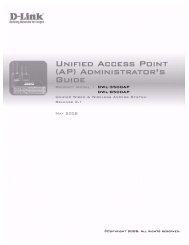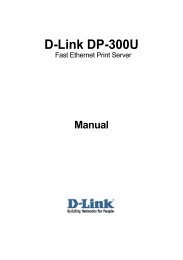Product Manual
Product Manual
Product Manual
Create successful ePaper yourself
Turn your PDF publications into a flip-book with our unique Google optimized e-Paper software.
DES-3526 / DES-3526DC Fast Ethernet Layer 2 Switch<br />
packet header.<br />
VLAN Selecting this option instructs the Switch to examine the VLAN part of each packet<br />
header and use this as the, or part of the criterion for forwarding.<br />
Source IP Mask Enter an IP address mask for the source IP address.<br />
Destination IP Mask Enter an IP address mask for the destination IP address.<br />
DSCP Selecting this option instructs the Switch to examine the DiffServ Code part of each<br />
packet header and use this as the, or part of the criterion for forwarding.<br />
Protocol Selecting this option instructs the Switch to examine the protocol type value in each<br />
frame's header. You must then specify what protocol(s) to include according to the<br />
following guidelines:<br />
Select ICMP to instruct the Switch to examine the Internet Control Message Protocol<br />
(ICMP) field in each frame's header.<br />
• Select Type to further specify that the access profile will apply an ICMP type<br />
value, or specify Code to further specify that the access profile will apply an<br />
ICMP code value.<br />
Select IGMP to instruct the Switch to examine the Internet Group Management<br />
Protocol (IGMP) field in each frame's header.<br />
• Select Type to further specify that the access profile will apply an IGMP type<br />
value<br />
Select TCP to use the TCP port number contained in an incoming packet as the<br />
forwarding criterion. Selecting TCP requires that you specify a source port mask<br />
and/or a destination port mask. The user may also identify which flag bits to deny.<br />
Flag bits are parts of a packet that determine what to do with the packet. The user<br />
may deny packets by denying certain flag bits within the packets, by checking the<br />
boxes corresponding to the flag bits of the TCP field. The user may choose between<br />
urg (urgent), ack (acknowledgement), psh (push), rst (reset), syn (synchronize), fin<br />
(finish).<br />
• src port mask - Specify a TCP port mask for the source port in hex form (hex<br />
0x0-0xffff), which you wish to deny.<br />
• dest port mask - Specify a TCP port mask for the destination port in hex<br />
form (hex 0x0-0xffff) which you wish to deny.<br />
Select UDP to use the UDP port number contained in an incoming packet as the<br />
forwarding criterion. Selecting UDP requires that you specify a source port mask<br />
and/or a destination port mask.<br />
• src port mask - Specify a TCP port mask for the source port in hex form (hex<br />
0x0-0xffff).<br />
• dest port mask - Specify a TCP port mask for the destination port in hex<br />
form (hex 0x0-0xffff).<br />
protocol id - Enter a value defining the protocol ID in the packet header to mask.<br />
Specify up to 5, Layer 4 port masks for the destination port in hex form (hex 0x0-<br />
0xffffffff).<br />
The window shown below is the Access Profile Configuration window for Packet Content Mask.<br />
88

















